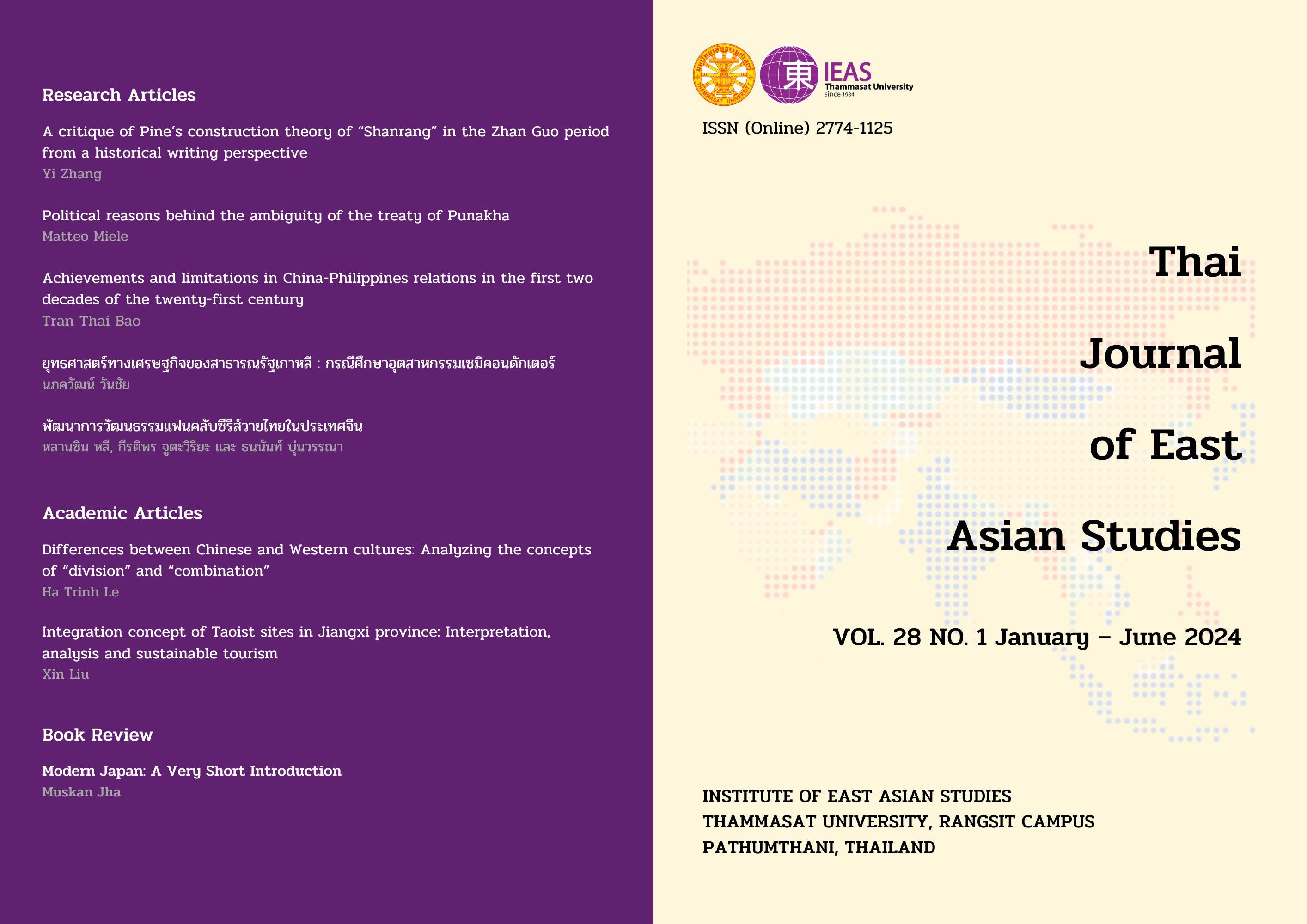Integration concept of Taoist sites in Jiangxi province: Interpretation, analysis and sustainable tourism
Keywords:
sustainable tourism, authenticity, Taoist heritageAbstract
This paper aims to help Taoist heritage sites achieve sustainable tourism. Mount Longhu has been related to the Zhengyi sect of Taoism since the Song Dynasty, and the neighboring San Qing Gong and Tiezhu Palace temple complexes should be examined as part of the Taoist landscape for sustainable tourism. The cultural significance of the Burra Charter for sustainable heritage management will be used as principal methodology, supplemented by field study. Results show that integrating authentic Taoist sites in Jiangxi Province, China demonstrate the relative completeness of the Taoist landscape and form a solid basis for sustainable local tourism.
Downloads
References
Australia ICOMOS. (2013A). The Burra Charter. The Australia ICOMOS Charter for Places of Cultural Significance. ICOMOS Australia. https://australia.icomos.org/wp-content/uploads/The-Burra-Charter-2013-Adopted-31.10.2013.pdf
Australia ICOMOS. (2013B). Practice Note: Understanding and assessing cultural significance. ICOMOS Australia. https://australia.icomos.org/wp-content/uploads/Practice-Note_Understanding-and-assessing-cultural-significance.pdf
Baidu Maps. (2023). Route Mount Sanqing, the Great Shangqinggong Temple Complex Ruins and Tiezhu Wanshougong Temple Complex. https://map.baidu.com/@13030816.800897103,3307249.089924085,10.28z
Baudrillard, J. (1983). Part V. 28. The precession of simulacra. In M. E. Durham & D. M. Kellner, (Eds.), Media and Cultural Studies KeyWorks (pp. 447-481). Blackwell Publishing Ltd.
Brundtland, G. H. (1987). Report of the World Commission on Environment and Development: Our Common Future. Geneva, UN-Dokument A/42/427. http://www.un-documents.net/ocf-ov.htm
Carreira, V. A., González‐Rodríguez, M. R., & Díaz-Fernández, M. C. (2021). The relevance of motivation, authenticity and destination image to explain future behavioural intention in a UNESCO World Heritage Site. Current Issues in Tourism, 25, 650-673.
Cernat, L., & Gourdon, J. (2007). Is the concept of sustainable tourism sustainable? Developing the Sustainable Tourism Benchmarking Tool. United Nations Publication. https://unctad.org/system/files/official-document/ditctncd20065_en.pdf
Cheng, S., Li, Y., Zhang, X., & Li, Z. (2017). 宗教文化旅游对游客的影响研究——以武当山道教文化旅游为例.地理科学, 37(10), 1569-1576.
Chinanews. (2023). 江西龙虎山大上清宫遗址正式开园集保护与陈列展览于一体. https://baijiahao.baidu.com/s?id=1782973892852914601&wfr=spider&for=pc]
Dean, M. (1973). Staged Authenticity: Arrangements of Social Space in Tourist Settings. American Journal of Sociology, 79(3), 589-603.
Department of Environment and Heritage Protection. (2013). Assessing cultural heritage significance: using the cultural heritage criteria: guideline/prepared by: Heritage Branch. https://nla.gov.au/nla.obj-2742626835/view
Editorial Committee of Dexing Local Chronicles (ed.). (1993). 德兴县志.北京,中国:光明日报出版社. http://www.jxsfzg.cn/id_281/chapter.shtml]
Feixian Pagoda. (n.d.).飞仙台介绍牌. 三清山国家公园
Goodland, R., Daly, H., & Serafy, S. El. (1991). Environmentally Sustainable Economic Development: Building on Brundtland, The World Bank Environment Working Paper no.46. World Bank Group. http://documents.worldbank.org/curated/en/332821467989482335/Environmentally-sustainable-economic-development-building-on-Brundtland
Google Maps. (2024). The Archaeological Site of the Great Shangqinggong Temple Complex Ruins after the Protection Project by the Government. https://www.google.com/maps/place/Da+Shangqinggong/@28.0467676,117.0455264,243m/data=!3m1!1e3!4m6!3m5!1s0x343bd33a2c7ceaaf:0x531a12c6bffe79ec!8m2!3d28.04129!4d117.049578!16s%2Fg%2F1tfprz0v?entry=ttu)
Guo, Y. (2010). 周易(中华大字经典)[Zhou Yi (annotated version- Classic Series of Chinese Large Font Size)]. Zhonghua Shuju.
Han Dian Online Dictionary. (n.d.). 魁(网络)[The meaning of Kui (online)]. https://www.zdic.net/hans/%E9%AD%81.
ICOMOS. (1964). International Charter For The Conservation And Restoration of Monuments And Sites (The Venice Charter 1964) (IInd International Congress of Architects and Technicians of Historic Monuments, Venice, 1964. https://www.icomos.org/images/DOCUMENTS/Charters/venice_e.pdf
Jiao Y. (2018). 江西万寿宫与净明道商业伦理.世界宗教研究,(5), 116-123.
King, R. (2018). Seoul: Memory, Reinvention, and the Korean Wave. University of Hawaii Press.
Kuhlman, T., & Farrington, J. W. (2010). What is Sustainability?. Sustainability, 2(11), 3436–3448. https://doi.org/10.3390/su2113436
Li, S., Y. (Ed.). (1987). 道教大辞典[Taoism Dictionary]. Zhejiang Guji Chubanshe.
Luo, X., J. (2018). 明清江西会馆建筑原型和类型研究 [The Research of Prototype and Type of Jiangxi Guild Hall Building in Ming and Qing Dynasty] [Doctoral Dissertation, Huazhong University of Science and Technology]. Wangfang Data. https://d.wanfangdata.com.cn/thesis/ChJUaGVzaXNOZXdTMjAyMDEwMjgSCUQwMTU0NjU2MhoIYTE1Zjh6dzk%3D.
McNulty, R., & Koff, R. (2014). Cultural Heritage Tourism. Partners for Livable Communities. https://www.americansforthearts.org/sites/default/files/culturalheritagetourism.pdf
Meadows, D. (1998). Indicators and Information Systems for Sustainable Development. Sustainability Institute. https://edisciplinas.usp.br/pluginfile.php/2144558/mod_folder/content/0/texto_21_information_systems.pdf
Moore, K., Buchmann, A., Mansson, M., & Fisher, D. (2021). Authenticity in tourism theory and experience. Practically indispensable and theoretically mischievous? Annals of Tourism Research, 89, 1-11.
Mount Sanqing Introduction. (n.d.). 三清宫介绍牌. 三清山国家公园
Pavlić I., Portolan, A., and Puh, B. (2017). (Un) supported current tourism development in UNESCO protected site: The case of Old City of Dubrovnik. Economies, 5(1), 913. https://doi.org/10.3390/economies5010009
Sanqinggong. (n.d.). 三清宫介绍牌. 三清山国家公园.
Taoist Mr Miao. (2022). 三清宫监院. 采访, 于11月12号.
Temple pillar in fornt of Xu Xun Hall. (n.d.). The introduction board of the temple pillar in front of Xu Xun Hall.
The Well of Locking Dragon by Iron Pillar. (n.d.). The introduction board of The Well of Locking Dragon by Iron Pillar.
Tiezhu Wanshougong Temple. (n.d.). The introduction board in the Tiezhu Wanshougong Temple.
Tonn, B. (2007). Futures sustainability. Futures, 39(9), 1097–1116. https://doi.org/10.1016/j.futures.2007.03.018
UNESCO World Heritage Centre. (2021). Operational Guidelines for the Implementation of the World Heritage Convention. https://whc.unesco.org/en/guidelines
UNESCO. (2008). Mount Sanqingshan National Park. https://whc.unesco.org/en/list/1292/
United Nations. (1992). The United Nations Conference on Environment & Development, Rio de Janerio, Brazil, 3 to June 14 1992. https://www.un.org/en/conferences/environment/rio1992
World Tourism Organization (2004). Indicators of Sustainable Development for Tourism Destinations: A Guidebook. World Tourism Organization
Zhang, S. L., Zhong, Z. P., & Zhou, G. X. (2012).(西汉)董仲舒:春秋繁露(注解版)[(Western Han Dynasty) Dong Zhongshu: Chunqiu Fanlu (annotated version)]. Zhonghua Shuju.
Downloads
Published
How to Cite
Issue
Section
License
Copyright (c) 2024 Thai Journal of East Asian Studies

This work is licensed under a Creative Commons Attribution-NonCommercial-NoDerivatives 4.0 International License.



